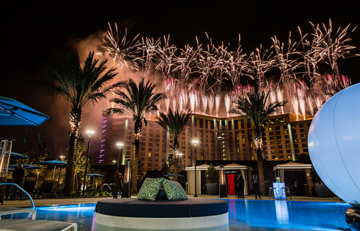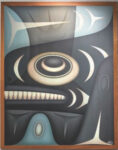
In the 33 years since the Poarch Band of Creek Indians opened their first bingo hall in rural Alabama, it’s fair to say the tribe has prospered beyond many expectations. Wind Creek Hospitality now owns five U.S. casinos (in Alabama, Nevada and Florida); acquired two more in the Caribbean last year; and in March, flexed its considerable financial muscle to buy Sands Bethlehem in Pennsylvania’s Rust Belt. The price tag: $1.3 billion.
When the Sands marquee is replaced by the Wind Creek brand—the sale is subject to approval by regulators—nods to tribal culture will likely be integrated into the property’s iconic steel stacks and blast furnaces. But how that will look is anyone’s guess. Tribal design has never been one thing; as nations expand, design has become more expansive too, and in some cases rivals Vegas for contemporary glitz.
Going Big
The $180 million expansion of Harrah’s Ak-Chin in Maricopa, Arizona, due for completion this year, will add new restaurants, meeting space, a 12-story hotel and a parking garage, making Ak-Chin the largest tribal resort in Arizona.
In the O’odham language, Ak-Chin means “people at the mouth of the wash,” or arroyo. That was a good starting place for Thalden Boyd Emery Architects, which worked with the tribe to ensure indigenous elements are correctly represented and also to unify the façade of the property, which has undergone several expansions since it opened in 1994.
“Maricopa is basically an oasis, a watering place,” says Thalden Vice President Nick Schoenfeldt. “The guest rooms, while very contemporary, pick up on that blue of that water. The surrounding land is used to farm potatoes, pecans and cotton, and in the casino area we have custom mosaics that represent that.”
A new wine bar has “a very Napa, California feel, but still ties back to the community with tribal elements incorporated into the fireplaces and in the colors and textures,” says Schoenfeldt.
In the lobby, a basket-weaving pattern is visible in the underside of the lobby’s canopy, and a showpiece glass chandelier brings to mind bundles of dried devil’s claw seedpods. The space features sculpted columns that recall saguaro cactus. And outside, a terracotta cladding material is inspired by the community’s pottery-making heritage.
Some cultural references are overt, some understated. And sometimes it’s in the eye of the beholder.
At Seneca Buffalo Creek in upstate New York, the Hiawatha wampum belt, symbolizing a peace treaty forged by the Seneca, Cayuga, Onondaga, Oneida and Mohawk nations, is represented “in a way that’s respectful to the icon,” says Dike Bacon, principal of HBG Design.
“Abstract interpretations of tribal elements are incorporated in a way that non-native customers can enjoy as art, but which will speak to tribal members in a way that’s important to them culturally and personally.” One of the most memorable—and most frequently photographed—is the lit-from-within Tree of Peace, a centerpiece of the casino floor under a woven-wood ceiling.
Get Back
“We used to talk about creating surprises; now the surprise has to be photographable,” says Schoenfeldt. “On every project, we need a ‘wow,’ an ‘a-ha,’ an Instagram or selfie spot.”
That notion is embodied by Thalden’s work with the Nottawaseppi Huron Band of the Potawatomi, who wanted to bring a stronger tribal feel to the Firekeepers Casino Hotel in Battle Creek, Michigan.
“It was a very contemporary space, but they said, ‘We went a little far with that; there’s nothing that really says who we are,’” says Schoenfeldt. A solution was found in the Seven Grandfathers, who according to legend bestowed seven gifts—wisdom, love, respect, bravery, honesty, humility and truth—on a newborn child of the nation. In keeping with the legend, tribal members are always mindful of the seven generations that preceded them, and always plan for the seven generations to come.
“Our design team talked with the tribe about how to do that in a contemporary manner,” says Schoenfeldt. “We incorporated seven structural columns in the hotel lobby, each representing a grandfather. On each side of the columns there are the seven wisdoms, one in English and one in their native tongue. It tells the story without being in your face, and is highly successful.
“Tribes have gotten away from the nuts-and-twigs look of a lot of lodge-themed facilities,” he says. “We didn’t start that. They did. We just built on it.”
Star of the Show
The $285 million expansion of Pechanga Resort & Casino in Temecula, California, completed last winter, added 568 luxury rooms and suites with floor-to-ceiling windows for views of the surrounding mountains. An opulent two-story spa is also glass-enclosed to showcase the region’s natural beauty. A new ballroom is topped by a green roof. The expansion added two restaurants and 68,000 square feet of meeting and event space.
But a new 4.5-acre pool complex has been called “the star of the show.”
The 8,500-square-foot main pool features a swim-up bar with 18 submerged barstools, a Baja ledge for chaise lounges, and a zero-edge pool surrounded by cabanas. There’s a splash pad for kids, two water slides and a beach entry pool.
The lavish pool area meets or exceeds anything available in Vegas, and will enable the Pechanga Band of Luiseño Indians to “expand the opportunities to offer special events,” says Julie Brinkerhoff-Jacobs, president of Lifescapes International, which has designed the landscaping, pools and attractions for more than 35 casino hotels and resorts around the world. “It’s not only about providing terrific guest experiences, but also monetizing the spaces to increase profitability.”
Water “animates any space, from the entryway to the pool area to the interior. More and more with gaming facilities, tribal and non-tribal, the pool can be a center of special events,” transitioning easily from a daytime watering hole to an after-hours party space, she says.
At Pechanga, Lifescapes embedded sound equipment and lighting in the topiary, and layered plantings from low to high, “naturally following the curve and flow of the design and almost guiding you through the property,” says Brinkerhoff-Jacobs. The lavish additions—which preserved the tribe’s “signature trees,” mature California peppers and oak—make the resort the largest of its kind on the West Coast.
The Tribal Difference
The growth of tribal properties “is driven by many reasons,” chiefly the expectations of guests, says Bacon. “Customers are experienced and savvy. If they don’t get what they want in one spot, they’ll get it somewhere else. The level of online communication and critiques on social sites is driving a lot of facilities to elevate their level of quality and creating more memorable experiences.”
But in the age of destination resorts, do customers still expect a different vibe and look from tribal properties?
“I don’t know that they expect something different, but they potentially get something different,” says Howard Tribble, senior vice president of design and construction for Caesars Entertainment. “You can make adjustments and refinements but not wholesale changes—the tribe’s history is too important.
“If a tribal resort is done well, it can feel friendlier, more like a family enterprise, less glitzy and in-your-face. I would think and hope it has a more welcoming feel. It’s a different experience than a traditional commercial property. And that has a nice quality to it.”









